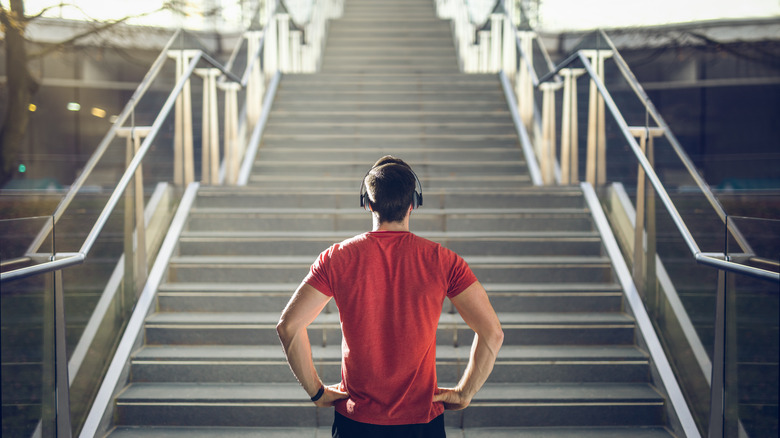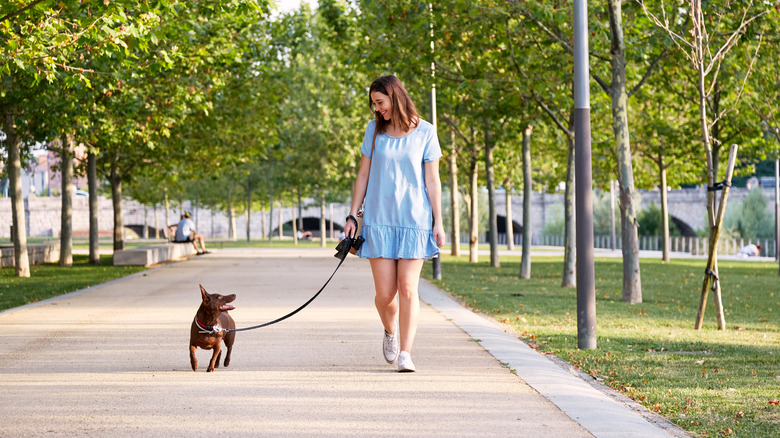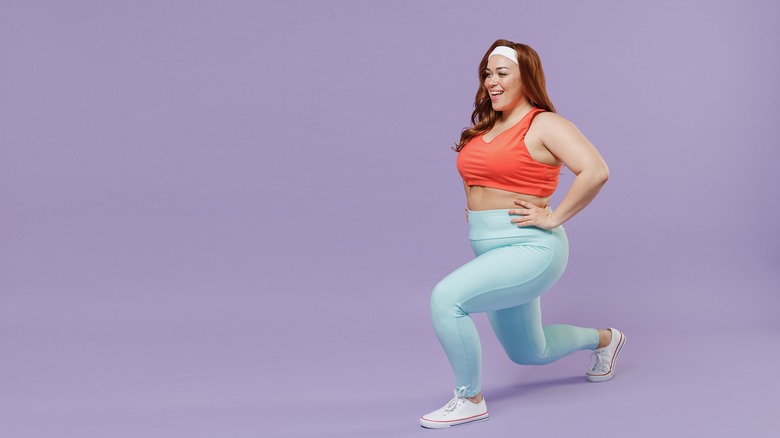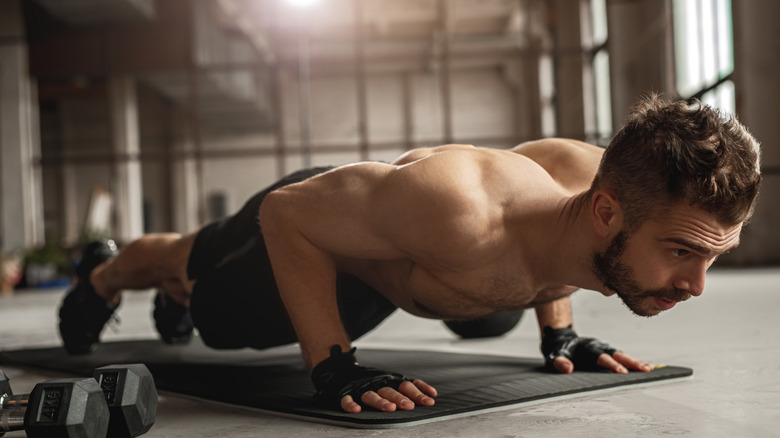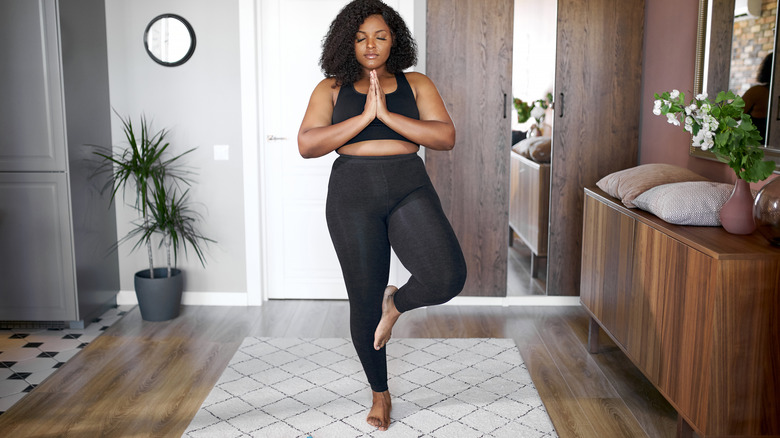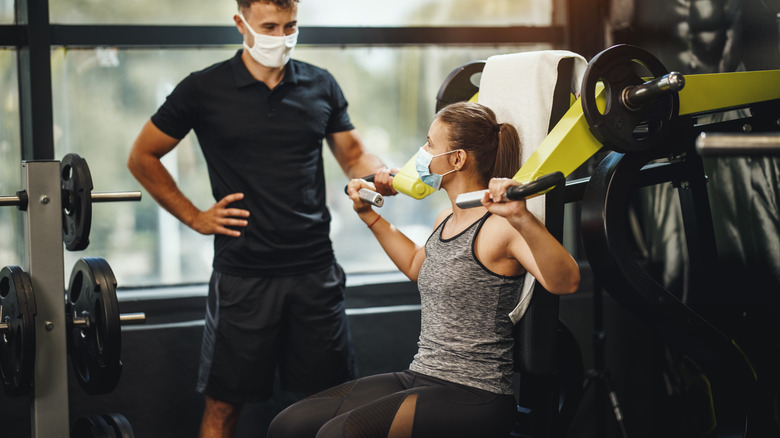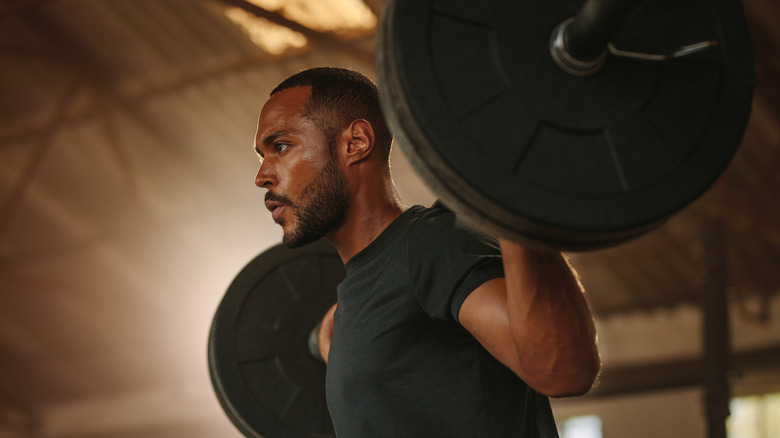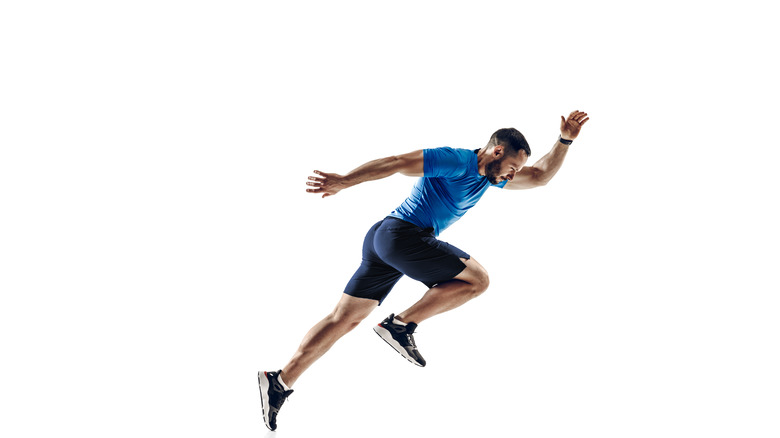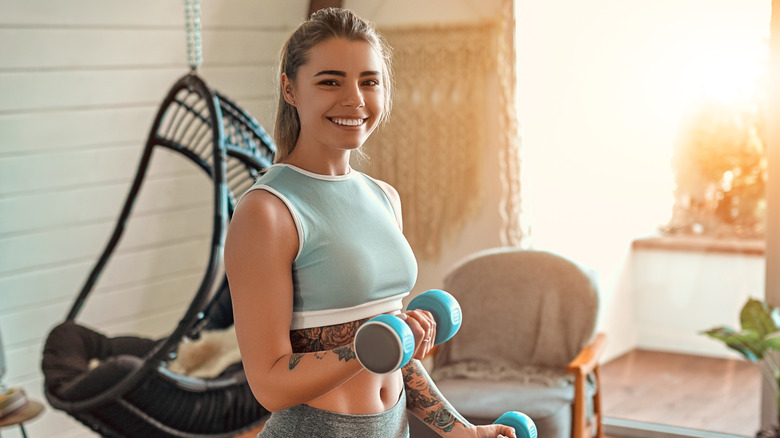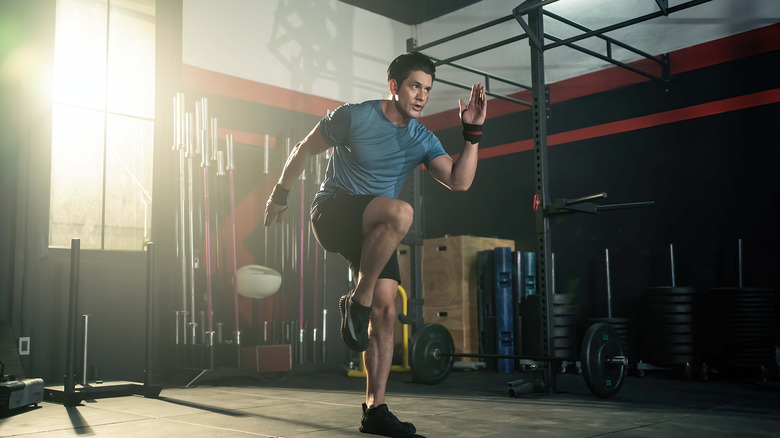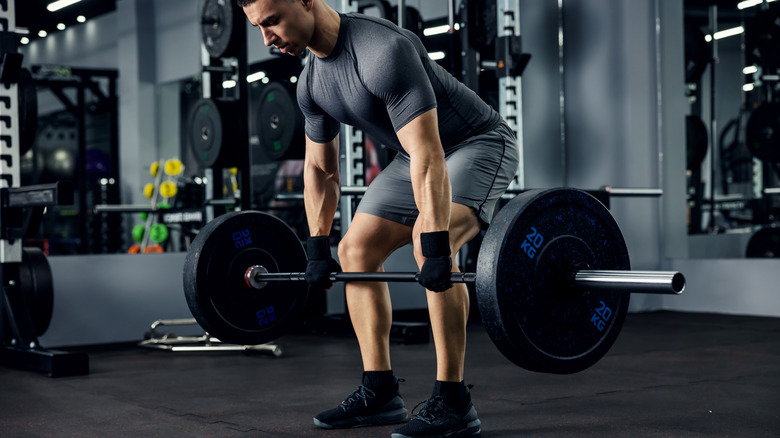The Best Workouts For People Who Hate Cardio
Some people enjoy the feeling of running mile after mile, swimming dozens of laps in the pool, or cycling for great distances. Others find cardio workouts boring or uncomfortable and would rather do something else. The benefits of doing cardio workouts are wide-ranging, according to the Cleveland Clinic. It improves your heart health, memory, bone health, mood, sleep, and even sexual function. Given all the health benefits of cardio, you might feel like you should just suck it up and run on the treadmill anyway.
Fortunately, there are other ways to improve your health without doing cardio workouts. For example, a study published in Frontiers in Sports and Active Living found that both intense weight training circuits and high-intensity interval circuits improved heart health. Another study, published in PLOS Medicine, found that resistance exercise was effective at reducing the risk of obesity compared with cardio exercise. These studies show that different styles of training can offer the same benefits as cardio workouts, so you don't need to feel limited in your choices.
Walking
If running, cycling, rowing, or swimming are all too uncomfortable for you, try a different type of cardio workout: walking. You need very little equipment to walk, and you can even do it on a treadmill if space is limited. It might not seem like much, but going for a brisk walk can decrease blood pressure, make your legs stronger, and boost your energy levels. It can also help you lose weight over time, per the University of California, Berkeley. They recommend a few different walking workouts, depending on your ability level.
Beginners should begin by walking at a pace of one mile every 17-20 minutes, says the article. Start by walking 10 minutes per day and slowly build up to 30 minutes of walking, 6 days per week. Intermediate walkers should go slightly faster (around 13 to 17 minutes per mile) and walk for longer (roughly 45 minutes). Advanced exercisers should aim for walking with a backpack with 5 to 10 pounds in it, walking up and down hills, or walking holding 2- to 3-pound dumbbells.
Lower body resistance workout
Weighted leg exercises can be very tiring. The leg muscles are large relative to your upper body muscles, and a difficult leg workout can leave you panting and sweating. The International Sports Sciences Association outlines a lower body weight training workout to build stronger legs. The first exercise they recommend is the squat. You can hold a dumbbell or kettlebell in front of your chest as you squat to increase the resistance, or start without weight if you find that challenging enough.
Deadlifts are next. You can use a barbell, which you pick up from the ground, or dumbbells, which you can use to perform a Romanian (or partial) deadlift. The article recommends lunges, which you can do without weight or while holding dumbbells by your sides. After that, use a leg press machine if you have access to one. Finally, end with calf raises, either holding dumbbells or without weight.
Upper body resistance workout
If your legs are sore and tired, you might want to do a weight workout for your upper body muscles only. The Oklahoma State University has a weight training workout for the upper body that covers all major muscle groups.
Start with a dumbbell bench press, lying on your back on a bench, pressing with each hand. Next, they recommend a standing shoulder (also called military) press, with either dumbbells or resistance bands. After that, do standing shoulder raises with a dumbbell in each hand or resistance bands.
The next exercise, also for the shoulders, is a standing lateral raise with your elbows only slightly bent. You can use dumbbells or a band for this as well. After that, try dumbbell rows, standing and slightly bent over. You can also perform this one arm at a time. Finish off your workout by doing bicep curls, with a dumbbell or band, then tricep extensions, lying on your back on a bench.
At-home strength workout
If you're at home with minimal equipment, you can still do an effective resistance training workout. You'll need a different form of resistance in the form of bands and your own bodyweight. The Hospital for Special Surgery outlines an effective at-home strength workout. The first exercise they recommend is a squat with a circular band wrapped around your knees. As you squat down, press your knees against the band to make it harder.
For your upper body, you can do a row. You'll need to secure a resistance band around a doorknob or another fixed object. Stand, facing the object, and pull your hands in toward your rib cage. For both the rows and squats, aim for 10 to 15 reps. Finally, perform a side plank to strengthen your core muscles. Make sure you hold the side plank for the same amount of time on each side.
Weight training circuit workout
Picking up the speed of your workout can help you save time and make your workout more effective. One way to speed up the pace of weight training is to perform exercises in circuits.
The American Council on Exercise recommends doing weight training circuits for fat loss, because they allow you to hit all areas of the body. The article recommends using heavy weights for each exercise, and limiting the amount of time you rest between each movement.
There are three circuits in the sample workout provided by the American Council on Exercise. In each circuit, you'll perform three sets per exercise. For the first circuit, you'll do a curl and press for 8 to 12 reps, followed by pushups for 15 reps, then a dumbbell row and fly for 8 to 12 reps. In the second circuit, you'll start with step-ups on a bench for 12 reps on each leg. After that, you'll do a lunge and front raise combination exercise for 12 reps on each leg. Finish the circuit with renegade rows with a dumbbell for 12 reps on each arm. In the third circuit, you'll do an incline dumbbell press for 8 to 12 reps. Then, do bench dips for 15 reps. The last movement is plank shoulder touches for 12 reps on each side.
50-minute total body workout
One reason to avoid long cardio workouts is that they're time-consuming. You can get an effective workout in 50 minutes, says an article from the National Academy of Sports Medicine (NASM). They advise breaking your session down into 7 different 6-minute blocks, with short transitions between each block.
The first part of your workout should be a warm-up, including some work on balance. You can walk or do simple bodyweight exercises to warm up. Then, you'll move on to lower body exercises.
For leg exercises, the NASM suggests dumbbell squats or bodyweight side lunges. Then, you'll move on to an ab workout section. You can do exercises that focus on stabilization and/or endurance, such as a front plank. Then you'll do agility drills, such as using an agility ladder or setting up cones to do running drills. After that, you can do 6 minutes of upper-body weight exercises, such as rows and chest press. Finish with a cooldown for 6 minutes.
HIIT training vs cardio
High-intensity interval training (HIIT) can mean a number of different things, but there's a big difference between it and steady-state cardio. When you do steady-state cardio, you perform an activity (such as cycling) at a constant speed for a set amount of time. When you do interval training, you do an activity for a short amount of time, but at a high intensity. The point of HIIT training is to cut down on the amount of time you spend exercising without giving up the benefits of cardio.
To test this theory, the authors of a study published in the Journal of Sports Science & Medicine split subjects into two groups. One group did 20-minute workouts on a bike at a steady pace. The other group did Tabata workouts, which are 8 rounds of an exercise with 20 seconds of high intensity and 10 seconds of rest. The researchers found that the Tabata workouts improved cardiovascular fitness as much as the steady-state groups.
Tabata workout
It might seem unbelievable, but you can make steady progress in your cardiovascular fitness by doing 4-minute workouts. Tabata, which is a form of high-intensity interval training, is a style of training that can be used in many different forms. As the Cleveland Clinic explains, you perform 8 rounds of an exercise with 20 seconds on and 10 seconds off. You can apply this format to different exercises. For example, you can do a kettlebell swing for 20 seconds, take a break, then repeat until your 4 minutes is up.
You can also do cardio or bodyweight exercises. For cardio, sprinting or using a stationary bike works well. For bodyweight training, you can do things like squats, push-ups, and lunges. You can also perform Tabata circuits back-to-back, which means you do one 4-minute circuit followed by others. Take it slow at first, because these circuits can be very challenging.
High rep weight workouts
Weight training workouts are a useful alternative to cardio, but they don't need to be limited to heavy weights and low reps. You can do high rep weight workouts, which are better for muscular endurance (via West Virginia University). For these workouts, you'll do each exercise for 12 to 16 reps. That'll force you to use a lighter weight. For that reason, these workouts are useful for beginners, since you can make the exercise more difficult without adding weight.
One movement you might want to try with high reps are back squats with a barbell on your back. You can also do the bench press if you'd like an upper body barbell exercise. The shoulder press can be performed with a barbell or dumbbells with low weight for high reps. Lat pulldowns, a cable exercise, are also useful for working the back muscles. You can do most weightlifting exercises for high reps, as long as you can drop the weight low enough to use proper form for every rep.
Other styles of HIIT training
Tabata training is just one type of high-intensity interval training. Other types change the amount of time you're resting versus working to make the intensity of the workout different. The National Academy of Sports Medicine describes different ways you can achieve an intense workout using these HIIT strategies. One way is with a 30:30 split, with 30 seconds of work and 30 seconds of rest. In this style, you'll do an exercise for 30 seconds, then rest for 30 seconds.
Another way to do HIIT is with a 30-20-10 strategy. With this style of training, you pick an exercise of moderate intensity to do for 30 seconds, like a front plank or a light jog. Then, you increase the intensity for 20 seconds. You can do so by transitioning from a plank to a push-up, for example, or a jog to a run. Finally, end with 10 seconds of all-out effort. You can finish with clap push-ups or an all-out sprint.
Cardio during resistance training
While you might not like cardio, you could sneak it into your weight training workouts. Instead of resting between sets, you could keep your heart rate elevated by going from each resistance exercise to a cardio exercise. This means you're not doing cardio for an extended length of time; rather, you're doing sprints. This is otherwise known as "combination training." A study published in BMC Public Health explored the effects of combined training versus strictly weights or cardio.
In the study, the groups each exercised for 12 weeks. The researchers found that combination training was more effective than doing one type of training at a time for fat loss. It was also better for weight loss and improving cardiovascular fitness. That means you can simply combine cardio with your strength training workouts, without worrying that you'll lose some of the benefits of doing a pure cardio workout.
Zumba fitness classes
One reason to avoid doing cardio workouts is boredom. Jogging on a treadmill for 20 or 30 minutes without any breaks can get very dull. On the other hand, some forms of cardio are so entertaining that you don't even realize what you're doing. Dance workouts are entertaining and challenging, which makes them a good alternative to traditional cardio.
A study published in the International Journal of Environmental Research and Public Health found that 16 weeks of Zumba fitness classes improved health-related quality of life measures in middle-aged women. In particular, they note that vitality and mental health scores improved dramatically. The researchers examined one group that didn't exercise, compared to a group that only did dance and another group that danced and did additional strength training. They found that there wasn't much difference between the group that only danced and the one that added weight training, suggesting that Zumba fitness classes alone are enough to give you health benefits.
Play sports
Learning a new sport or picking back up an activity that you used to do can help you stay in shape. Joining a recreational league or team is also a great way to meet people and make new friends. Try to pick a sport that's active, such as soccer, tennis, or basketball. It should be physically challenging to the point where you're sweating or breathing harder during the activity.
A paper published in Sports (Basel) discusses the effects of starting a sport on adults. The authors found that sports were physically beneficial because they combat what the authors see as a growing problem of inactivity in the daily life of adults. Sports help burn calories and fight the growing excess energy surplus that an increasing number of people face. They also found that there were mental health benefits to playing sports. Depression and anxiety symptoms seemed to ease. Additionally, people who played sports tended to drink less alcohol. Plus, playing sports can be a fun break from daily life.
Go for a hike
Getting outdoors into nature can be a great way to increase your activity level without the boredom of cardio. As you climb a mountain or raft down a whitewater river, it's hard to be bored. One of the benefits of nature is the sheer number of breathtaking sights, which can distract you from the difficulty of the exercise you're doing. Harvard Health recommends hiking as a way to improve your cardiovascular fitness.
You can make your hike harder by finding hills to climb. You can also wear a pack with gear like water or food to weight yourself down. Hiking along an uneven surface, such as rocky terrain, can improve your balance and core stability. Plus, hiking is a stress reliever. Just make sure that you bring essentials on your hike, including well-fitting boots and enough water to stay hydrated. You can also use hiking poles for added assistance if you have trouble with your vision or balance.

